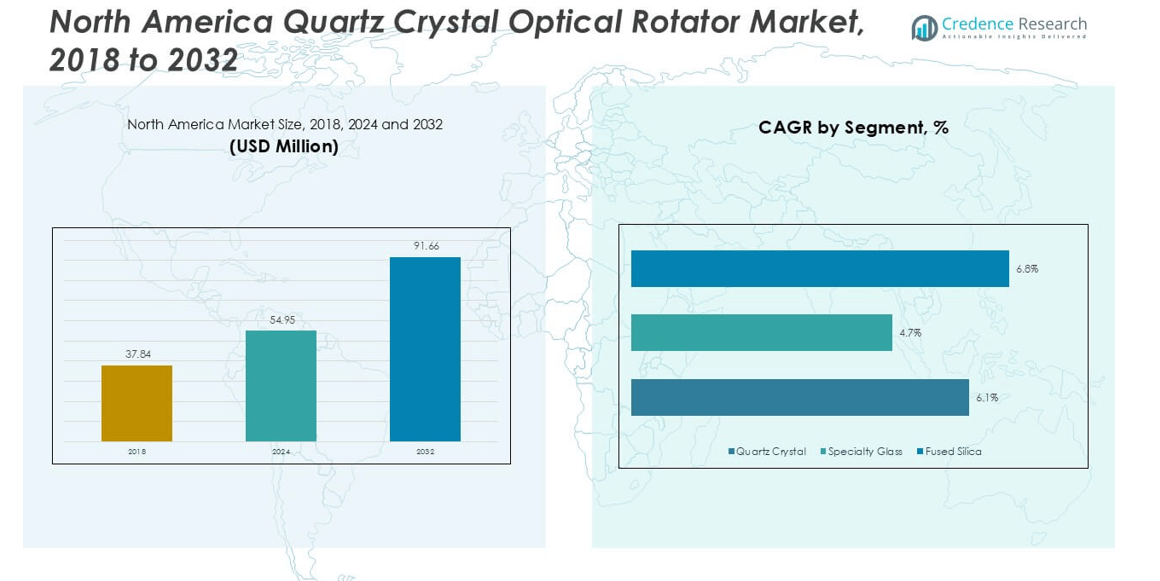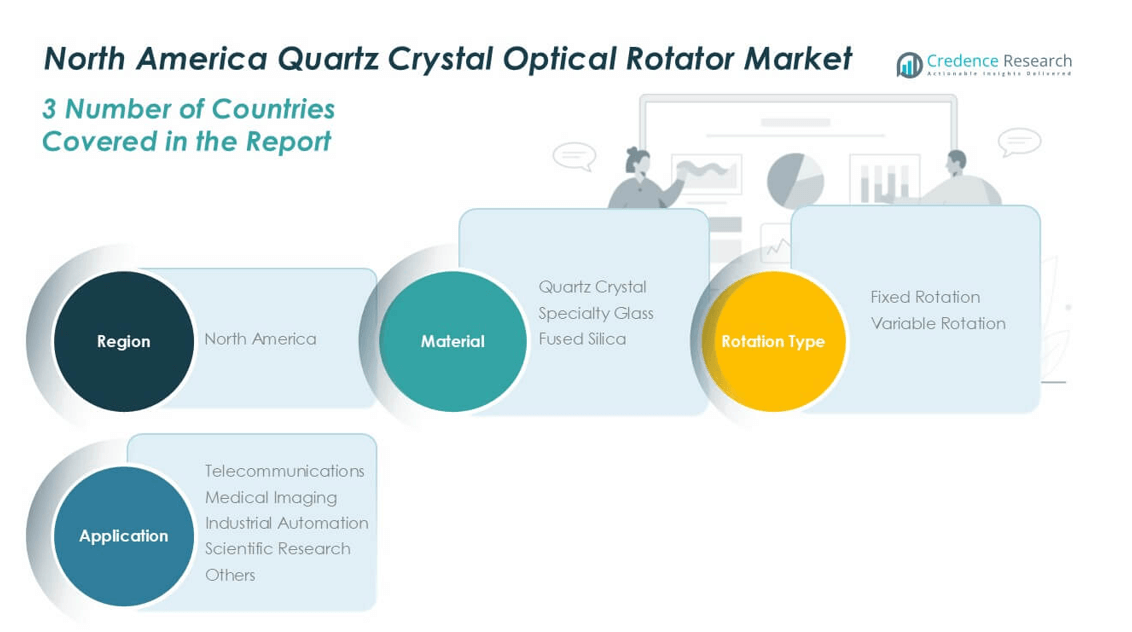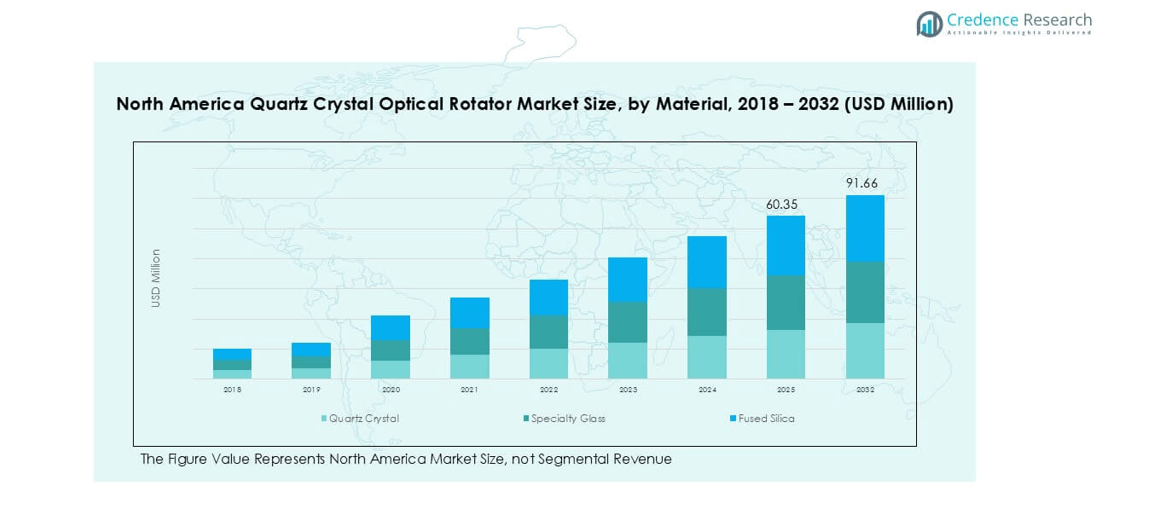Market overview
North America Quartz Crystal Optical Rotator market size was valued at USD 37.84 million in 2018, reaching USD 54.95 million in 2024, and is anticipated to reach USD 91.66 million by 2032, at a CAGR of 6.2% during the forecast period.
| REPORT ATTRIBUTE |
DETAILS |
| Historical Period |
2020-2023 |
| Base Year |
2024 |
| Forecast Period |
2025-2032 |
| North America Quartz Crystal Optical Rotator Market Size 2024 |
USD 54.95 million |
| North America Quartz Crystal Optical Rotator Market, CAGR |
6.2% |
| North America Quartz Crystal Optical Rotator Market Size 2032 |
USD 91.66 million |
The North America quartz crystal optical rotator market is highly competitive, with leading players such as Advanced Photonics Corporation, Crystal Dynamics Inc., CrystalPro Technologies LLC, PolarTech Corporation, and LuminaOptics Inc. driving innovation through advanced product portfolios and strategic collaborations. These companies focus on serving high-growth applications in telecommunications, medical imaging, and industrial automation, ensuring strong market presence. Regionally, the United States leads with over 70% share in 2024, supported by extensive 5G infrastructure, advanced healthcare facilities, and strong R&D investments. Canada follows with around 18% share, driven by healthcare research and expanding telecom networks, while Mexico holds nearly 12%, supported by its growing industrial automation and electronics manufacturing sectors. This concentration highlights the U.S. as the dominant growth hub, with Canada and Mexico emerging as important secondary markets

Market Insights
- The North America quartz crystal optical rotator market was valued at USD 54.95 million in 2024 and is projected to reach USD 91.66 million by 2032, growing at a CAGR of 6.2%.
- Growing demand in telecommunications, driven by 5G rollout and data center expansion, is the key driver supporting steady adoption of quartz crystal optical rotators across the region.
- Market trends highlight increased use in medical imaging and industrial automation, alongside rising opportunities in photonics and quantum research applications that require high optical precision.
- The competitive landscape includes key players such as Advanced Photonics Corporation, Crystal Dynamics Inc., CrystalPro Technologies LLC, and PolarTech Corporation, which focus on technological innovation and long-term supply partnerships.
- Regionally, the United States dominates with over 70% share, followed by Canada with 18% and Mexico with 12%, while by segment, quartz crystal material and fixed rotation types lead the market due to stability and precision.
Access crucial information at unmatched prices!
Request your sample report today & start making informed decisions powered by Credence Research Inc.!
Download Sample
Market Segmentation Analysis:
By Material
Quartz crystal dominated the North America quartz crystal optical rotator market in 2024, accounting for over 55% of the total share. Its dominance stems from superior optical activity, stability, and suitability for high-frequency applications. Quartz crystal continues to be the preferred material in telecommunication systems and scientific research devices requiring high accuracy. Specialty glass and fused silica serve niche requirements, particularly in customized optical systems where cost and flexibility are critical. However, the demand for quartz crystal remains the strongest, driven by its reliability and widespread adoption across advanced optical instruments.
- For instance, Edmund Optics offers crystalline quartz rotators with fixed 45° or 90° rotation optimized for 1064 nm or 532 nm lasers.
By Rotation Type
Fixed rotation held the dominant share in 2024, contributing nearly 60% of the market. These devices offer stable optical performance, minimal calibration needs, and high precision, making them well-suited for industrial automation and communication systems. Fixed rotation types are preferred in applications where consistency is vital, such as telecom signal processing and imaging devices. Variable rotation rotators are gaining momentum, particularly in research and healthcare applications, due to their flexibility and adjustable functionality. Yet, fixed rotation continues to lead the segment, supported by its robust usage in high-volume and standardized systems.
- For instance, quartz fixed rotators from Karl Lambrecht offer rotation tolerances of ±0.06° at 1064 nm and ±0.7° at 347 nm.
By Application
Telecommunications led the application segment in 2024, capturing close to 40% share of the market. Growing reliance on optical communication systems, data centers, and 5G networks has accelerated the adoption of quartz crystal optical rotators. The demand for reliable optical components in high-bandwidth communication links positions telecommunications as the largest revenue contributor. Medical imaging and industrial automation also show strong growth potential, as advanced imaging devices and automated manufacturing processes integrate rotator technologies. Scientific research continues to generate demand, though at a smaller scale, ensuring a diverse application landscape for market expansion.
Key Growth Drivers
Rising Adoption in Telecommunications Networks
The rapid expansion of high-speed communication networks is a primary driver of the quartz crystal optical rotator market in North America. The rollout of 5G infrastructure and growing reliance on fiber-optic networks require precise optical components that ensure minimal signal loss and improved polarization control. Quartz crystal rotators are increasingly integrated into optical switches, isolators, and circulators that are critical for efficient data transmission. Telecom operators in the region are investing heavily in upgrading networks to handle exponential data growth, creating steady demand for rotator technology. The stability and reliability of quartz crystal make it the preferred material for long-haul communication systems, ensuring its strong position in the market.
- For instance, PMOptics offers a quartz rotator covering 240–2100 nm with polarization rotation tolerance ±0.1° and wavefront distortion λ/8 @ 632.8 nm.
Growing Demand in Medical Imaging Applications
Medical imaging technologies are another strong growth driver for the North America quartz crystal optical rotator market. Advanced diagnostic tools such as MRI systems, endoscopy equipment, and optical coherence tomography (OCT) rely on precision optical devices to enhance imaging clarity. The rising incidence of chronic diseases and the need for early diagnosis are pushing hospitals and research institutions to invest in advanced optical imaging solutions. Quartz crystal rotators offer high precision and stability, which are essential in achieving accurate imaging results in sensitive diagnostic procedures. With healthcare expenditure in the U.S. among the highest globally, the market benefits from strong funding support for upgrading medical technologies. This demand is further reinforced by ongoing innovation in minimally invasive imaging techniques.
Expansion of Industrial Automation and Smart Manufacturing
Industrial automation is becoming a significant contributor to the quartz crystal optical rotator market in North America. Smart manufacturing facilities are deploying advanced optical systems for monitoring, sensing, and precision control in automated processes. Optical rotators enhance the performance of laser-based instruments and robotic vision systems used in production lines. With North American industries prioritizing efficiency, accuracy, and predictive maintenance, the demand for durable and reliable optical rotators is growing. Sectors such as aerospace, automotive, and electronics manufacturing increasingly depend on optical technologies for quality assurance and design optimization. The adoption of Industry 4.0 practices, coupled with strong investments in automation, ensures sustained growth for quartz crystal optical rotators in the industrial domain.

Key Trends & Opportunities
Integration of Quartz Crystal Rotators in 5G and Data Centers
The rise of 5G networks and hyperscale data centers presents a major trend and opportunity for the market. Quartz crystal optical rotators are essential in ensuring accurate polarization management in high-bandwidth optical transmission systems. As telecom providers race to improve network reliability and reduce latency, the demand for advanced optical components is set to rise. North America, being at the forefront of 5G deployment, is expected to generate substantial opportunities for component manufacturers. Data centers supporting cloud computing, artificial intelligence, and edge computing further amplify this demand. This trend ensures strong adoption of quartz-based rotators across digital infrastructure development.
- For instance, PMOptics offers a 45° quartz rotator for 1550 nm with polarization angle tolerance ±0.1° and wavefront distortion ≤ λ/8.
Advancements in Scientific Research and Photonics
Scientific research institutes in North America are continuously exploring new applications of optical rotators in quantum computing, photonics, and advanced materials studies. Universities and laboratories are investing in optical systems that demand ultra-high accuracy and stability. Quartz crystal rotators provide the performance required in precision experiments, driving their adoption in R&D. Growing funding for quantum technologies by the U.S. government enhances opportunities in this niche segment. Photonics research aimed at energy-efficient optical systems and next-generation computing also creates new avenues for growth. This trend positions quartz crystal rotators as essential tools for future innovations.
Key Challenges
High Production Costs and Material Limitations
One of the major challenges in the North America quartz crystal optical rotator market is the high production cost associated with quartz crystal processing. Precision cutting, polishing, and calibration of crystals require advanced manufacturing techniques and specialized equipment, raising the overall product cost. In addition, sourcing high-quality quartz that meets optical standards can be resource-intensive. These factors limit adoption among smaller enterprises or research institutions with restricted budgets. Competing materials such as specialty glass and fused silica, though less precise, offer cost advantages and threaten the widespread use of quartz-based rotators in certain applications.
Competition from Alternative Optical Technologies
The growing development of alternative optical technologies also poses a challenge for quartz crystal rotator adoption. Emerging solutions, including magneto-optical devices and advanced polarization control systems, are being explored as substitutes due to their lower costs and easier integration in compact systems. These alternatives could reduce the reliance on quartz crystal in some applications, especially where extreme precision is not required. Additionally, rapid technological evolution in optical communications and imaging creates uncertainty for quartz-based solutions, as new technologies may displace traditional rotators. Manufacturers must continue investing in innovation to maintain their competitive advantage against these emerging substitutes.
Regional Analysis
United States
The United States accounted for the largest share of the North America quartz crystal optical rotator market in 2024, holding over 70%. The country’s dominance is driven by its advanced telecommunications infrastructure, widespread 5G rollout, and significant investments in data centers. The strong presence of medical imaging manufacturers and healthcare institutions further supports demand. Industrial automation initiatives and research funding in photonics also contribute to growth. With robust R&D ecosystems and leading companies in optics and materials, the U.S. remains the primary hub for innovation and commercialization in the regional market.
Canada
Canada represented around 18% of the North America market in 2024. Growth is supported by expanding telecommunication networks, particularly with the ongoing nationwide 5G deployment. Canada’s strong focus on medical research and diagnostic imaging technologies also enhances adoption of quartz crystal rotators in hospitals and research centers. Additionally, investments in aerospace and industrial automation sectors provide new opportunities for optical components. Collaboration between universities, research labs, and photonics firms is helping to strengthen Canada’s role in niche optical technologies. The market outlook remains positive, driven by rising demand in healthcare and industrial sectors.
Mexico
Mexico held close to 12% of the North America quartz crystal optical rotator market in 2024. The country’s market is growing steadily, fueled by the expansion of industrial automation and increased adoption of optical technologies in automotive and electronics manufacturing. Telecommunications upgrades, supported by cross-border investments, also contribute to demand for advanced optical components. Mexico’s emerging medical technology sector further drives usage in diagnostic equipment. While smaller compared to the U.S. and Canada, Mexico offers strong potential due to its growing manufacturing base and adoption of Industry 4.0 practices, making it an increasingly important regional market.

Market Segmentations:
By Material
- Quartz Crystal
- Specialty Glass
- Fused Silica
By Rotation Type
- Fixed Rotation
- Variable Rotation
By Application
- Telecommunications
- Medical Imaging
- Industrial Automation
- Scientific Research
- Others
By Geography
- United States
- Canada
- Mexico
Competitive Landscape
The competitive landscape of the North America quartz crystal optical rotator market is shaped by both established optical component providers and emerging technology innovators. Companies such as Advanced Photonics Corporation, Crystal Dynamics Inc., and PolarTech Corporation maintain strong positions through broad product portfolios that support telecommunications, medical imaging, and industrial automation. Mid-sized firms like CrystalPro Technologies LLC and CrystalClear Optics LLC compete by offering specialized solutions tailored to research and niche applications. Strategic collaborations, research investments, and product innovations are central to competitive positioning, with firms actively focusing on enhancing optical precision, stability, and cost-efficiency. Additionally, recent developments highlight increased partnerships with telecom and healthcare equipment manufacturers, aimed at securing long-term supply contracts. This competitive environment emphasizes both technological leadership and the ability to address evolving application demands across sectors, ensuring continued rivalry and innovation in the regional market.
Shape Your Report to Specific Countries or Regions & Enjoy 30% Off!
Key Player Analysis
Recent Developments
- In June 2025, major showcasing of advanced photonics and optical systems occurred at the Laser World of Photonics event, featuring innovations relevant to high-precision optical manipulation.
Report Coverage
The research report offers an in-depth analysis based on Material, Rotation Type, Application and Geography. It details leading market players, providing an overview of their business, product offerings, investments, revenue streams, and key applications. Additionally, the report includes insights into the competitive environment, SWOT analysis, current market trends, as well as the primary drivers and constraints. Furthermore, it discusses various factors that have driven market expansion in recent years. The report also explores market dynamics, regulatory scenarios, and technological advancements that are shaping the industry. It assesses the impact of external factors and global economic changes on market growth. Lastly, it provides strategic recommendations for new entrants and established companies to navigate the complexities of the market.
Future Outlook
- The market will expand steadily, supported by the growing adoption of optical technologies.
- Telecommunications will remain the largest application area, driven by 5G and fiber-optic network growth.
- Medical imaging will continue to generate strong demand for high-precision optical components.
- Industrial automation will boost adoption as smart manufacturing and robotics gain traction.
- Scientific research will create new opportunities, especially in photonics and quantum technology projects.
- Quartz crystal will remain the dominant material due to its superior stability and reliability.
- Fixed rotation devices will retain leadership, but variable rotation systems will see faster adoption.
- The United States will sustain its leading role with the largest regional market share.
- Canada will strengthen its position through healthcare research and advanced telecom upgrades.
- Mexico will emerge as a growing market with rising adoption in manufacturing and electronics sectors.










